Document Generation APIs: Top 8 Features to Compare
Explore essential features of document generation APIs to automate workflows, enhance accuracy, and ensure security for your business needs.

Document Generation APIs: Top 8 Features to Compare
Looking for the best document generation API? Here's what you need to know: APIs like HTML2PDF, PDF Generator, DocRaptor, and PDF.co simplify creating PDFs, invoices, reports, and more from data sources like HTML or JSON. These tools are essential for businesses automating workflows in industries such as finance, healthcare, and e-commerce.
Key features to compare:
- Conversion Accuracy: Precision in handling complex layouts, CSS, and JavaScript.
- Performance: Speed, scalability, and batch processing capabilities.
- Security: Data encryption, compliance with U.S. standards, and secure storage.
- Pricing: Free tiers for testing, subscription plans, and credit-based models.
Quick Comparison:
| API Name | Free Tier Conversions | Paid Plans Start At | Key Features |
|---|---|---|---|
| HTML2PDF | 50/month | $17/month | Dynamic JavaScript rendering, S3 storage |
| PDF Generator | Yes | Varies | Template-based design, batch processing |
| DocRaptor | 5 documents (trial) | $19/month | Advanced CSS, JavaScript rendering |
| PDF.co | Pay-as-you-go | $9.99/month | AWS-based, credit-based pricing |
Pro Tip: Test free tiers to see how well the API fits your needs, from U.S.-specific formatting (e.g., $1,000.50, MM/DD/YYYY) to integration ease. Whether you're managing invoices or patient reports, these APIs can streamline your document workflows effectively.
Introducing Adobe Document Generation API (Paper Clips)
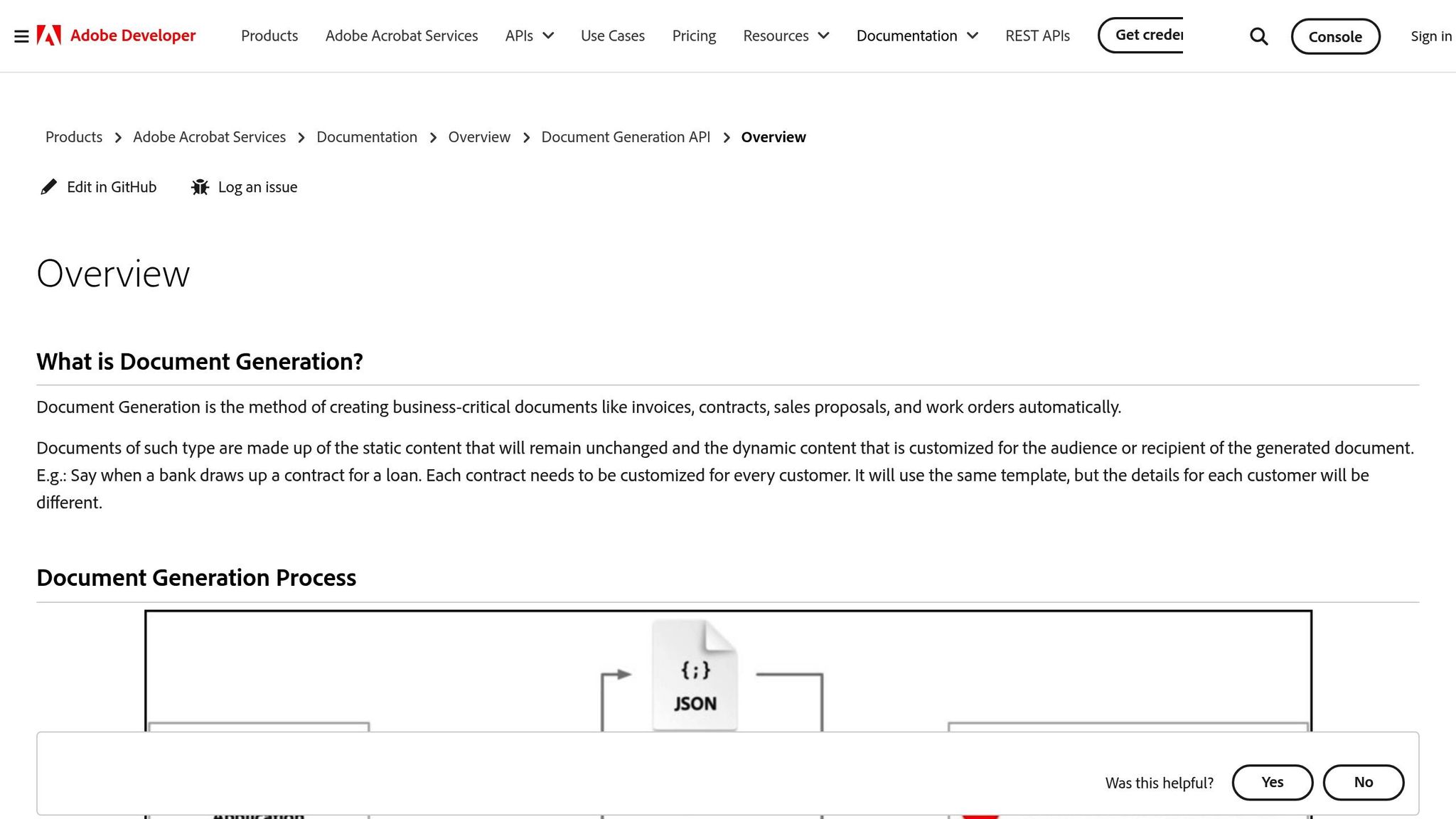
1. HTML2PDF API
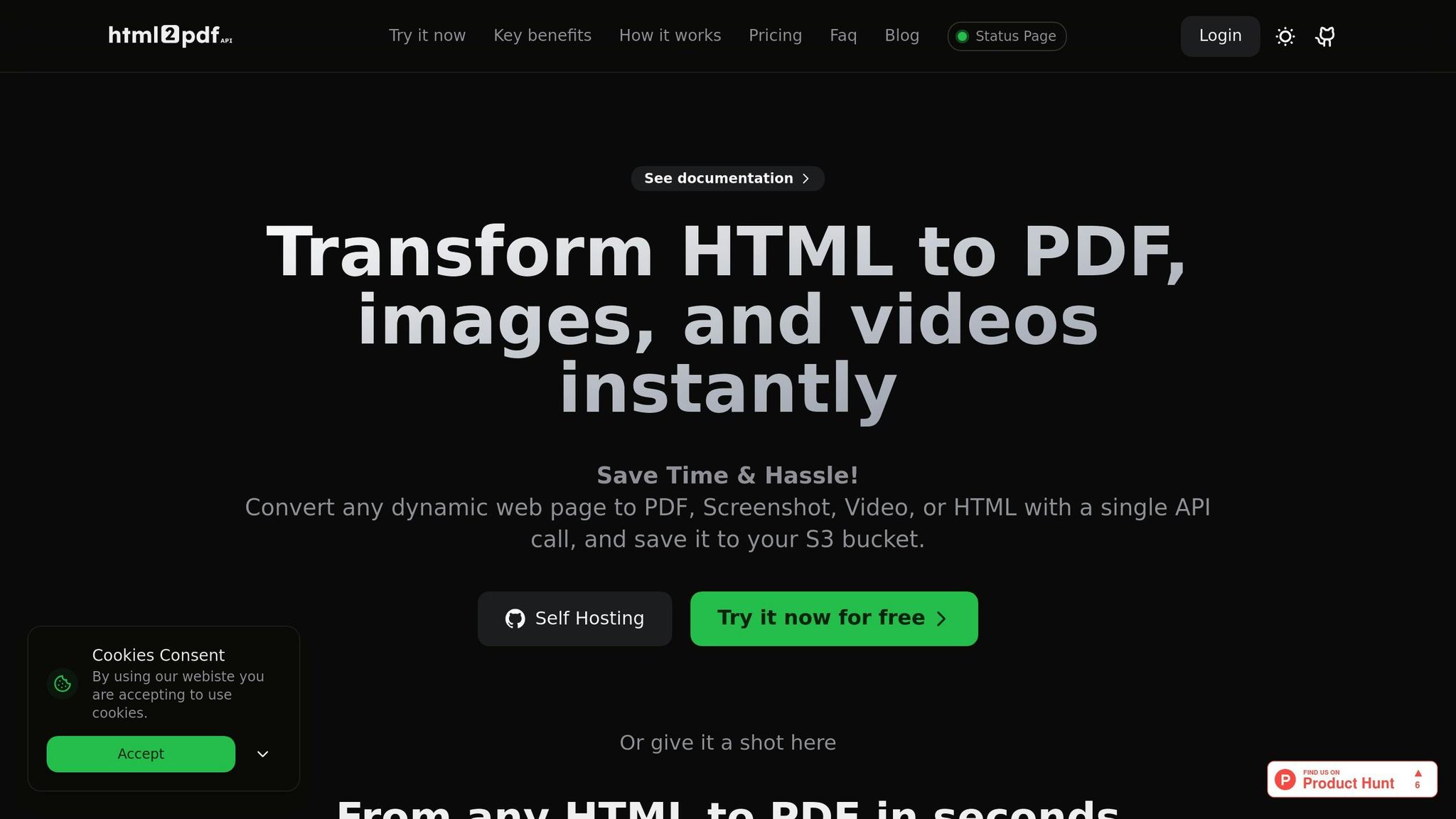
The HTML2PDF API simplifies the process of turning HTML into professional-quality PDFs, images, videos, or HTML files through an easy-to-use API. It’s especially handy for U.S. businesses managing automated document workflows, thanks to its support for dynamic JavaScript rendering. Below, we’ll explore how it stands out in terms of conversion accuracy, performance, security, and pricing.
Conversion Accuracy
This platform is designed to handle even the most complex HTML documents with precision. It supports advanced CSS styling, embedded images, and custom layouts, ensuring that formatting remains consistent during the conversion process. Whether you’re working on branded invoices or detailed reports, features like full-page screenshots and custom headers ensure professional results, complete with accurate currency and date formatting.
Another standout feature is its ability to execute JavaScript, meaning interactive or dynamically generated content is rendered correctly. Developers also have control over the process with options to block cookies and add custom headers, making it a versatile tool for tailored document creation.
Performance
When it comes to speed and scalability, HTML2PDF API delivers. Depending on the subscription tier, businesses can handle anywhere from 5 API requests per minute on the free plan to 200 API requests per minute on the Enterprise plan. This tiered system makes it easy to scale document generation as your business grows.
The API offers both synchronous and asynchronous processing, giving developers flexibility in how they integrate it. For large-scale or batch processing, asynchronous options help avoid timeouts, ensuring reliable performance even during high-demand periods. With unlimited storage and consistent output, you won’t have to worry about file retention limits slowing you down.
Security
Security is a top priority for HTML2PDF API. All data transmissions are protected with HTTPS encryption, and the platform includes secure file storage options. For businesses that need to meet U.S. compliance standards, the API integrates directly with S3 buckets, allowing generated documents to be stored securely within AWS infrastructure.
It also employs secure authentication methods and plans to introduce webhook notifications soon, enabling real-time updates on document generation. Higher-tier plans come with priority support, ensuring that any security concerns are addressed quickly.
Pricing
HTML2PDF API offers a straightforward pricing structure that caters to businesses of all sizes. The free plan includes 50 conversions per month, making it a great option for testing or small-scale projects. This allows developers to explore the platform’s capabilities before committing to a paid plan.
Paid plans start at $17 per month for the Pro tier, which includes 5,000 conversions and 100 API requests per minute. The Business plan, priced at $47 per month, offers 25,000 conversions and 150 API requests per minute. For larger needs, the Enterprise plan provides 100,000 conversions for $147 per month, along with the highest rate limits and priority support.
Every plan includes unlimited storage and S3 bucket integration, ensuring businesses can scale their document generation needs without worrying about hidden costs or limitations as they grow.
2. PDF Generator API
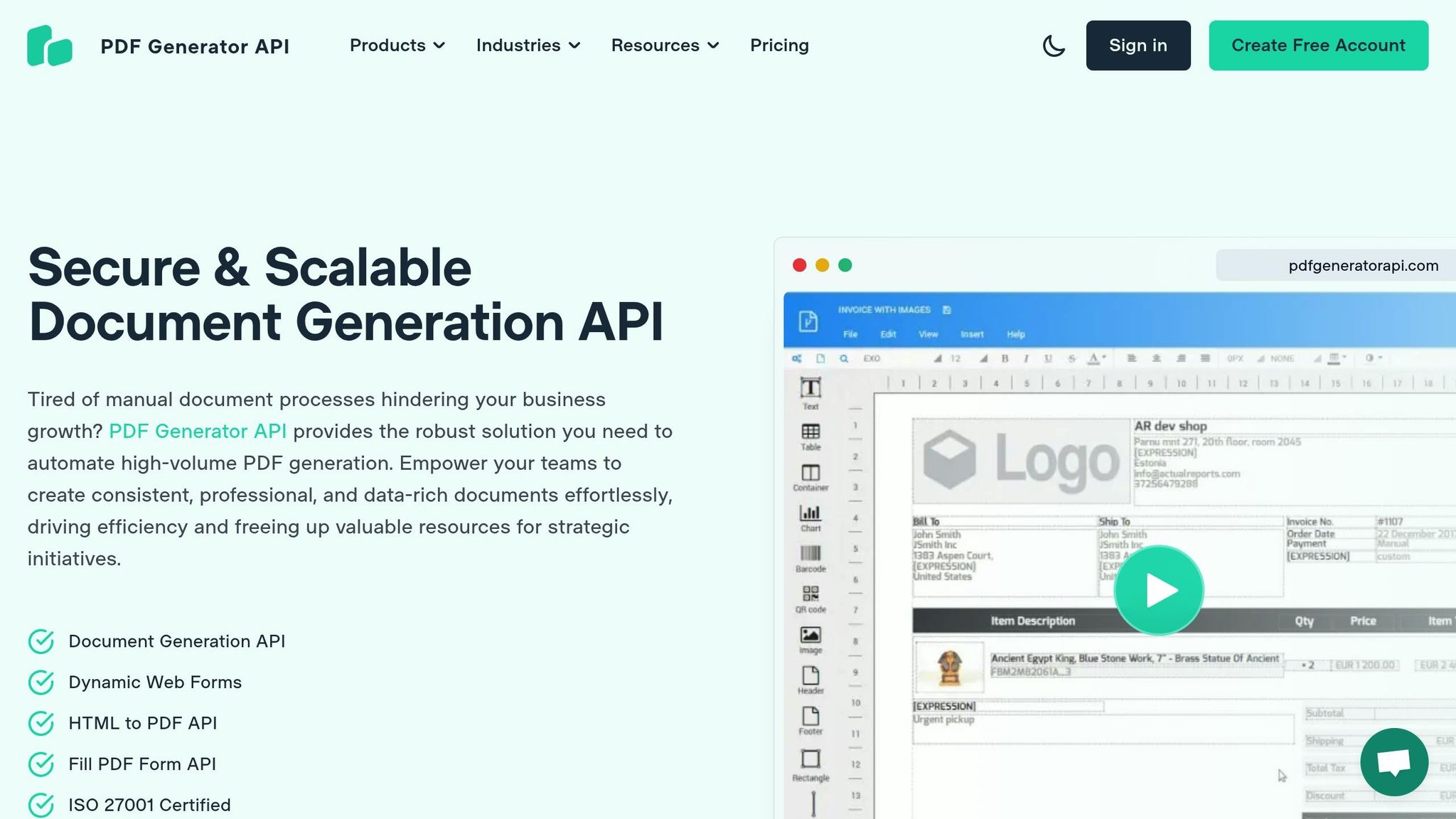
The PDF Generator API simplifies the creation of invoices, contracts, and reports by using templates to ensure a consistent format. This method integrates seamlessly with automated workflows, guaranteeing that elements like logos, headers, and footers are always in the right place. It’s especially handy when you’re dealing with a high volume of documents containing different data.
Conversion Accuracy
With its template system, the API delivers reliable and consistent formatting for every document. Dynamic placeholders in custom templates help maintain uniformity, eliminating the need for tedious reformatting after creation. This setup ensures precision, even in scenarios where large numbers of documents are processed.
Performance
The API supports batch processing, allowing you to generate multiple documents in a single call. This feature is a game-changer for workflows requiring frequent production of standardized documents, saving both time and effort.
Security
Security is a top priority for the platform. It employs industry-standard encryption to protect your data and offers configurable notifications to alert you when documents are ready. Additionally, it provides tools to help meet compliance requirements, combining strong security measures with practical usability.
Pricing
The PDF Generator API offers flexible pricing options to suit various needs. There’s a free tier for basic use, while higher-tier plans provide perks like increased document limits, faster processing, and access to advanced template features.
3. DocRaptor
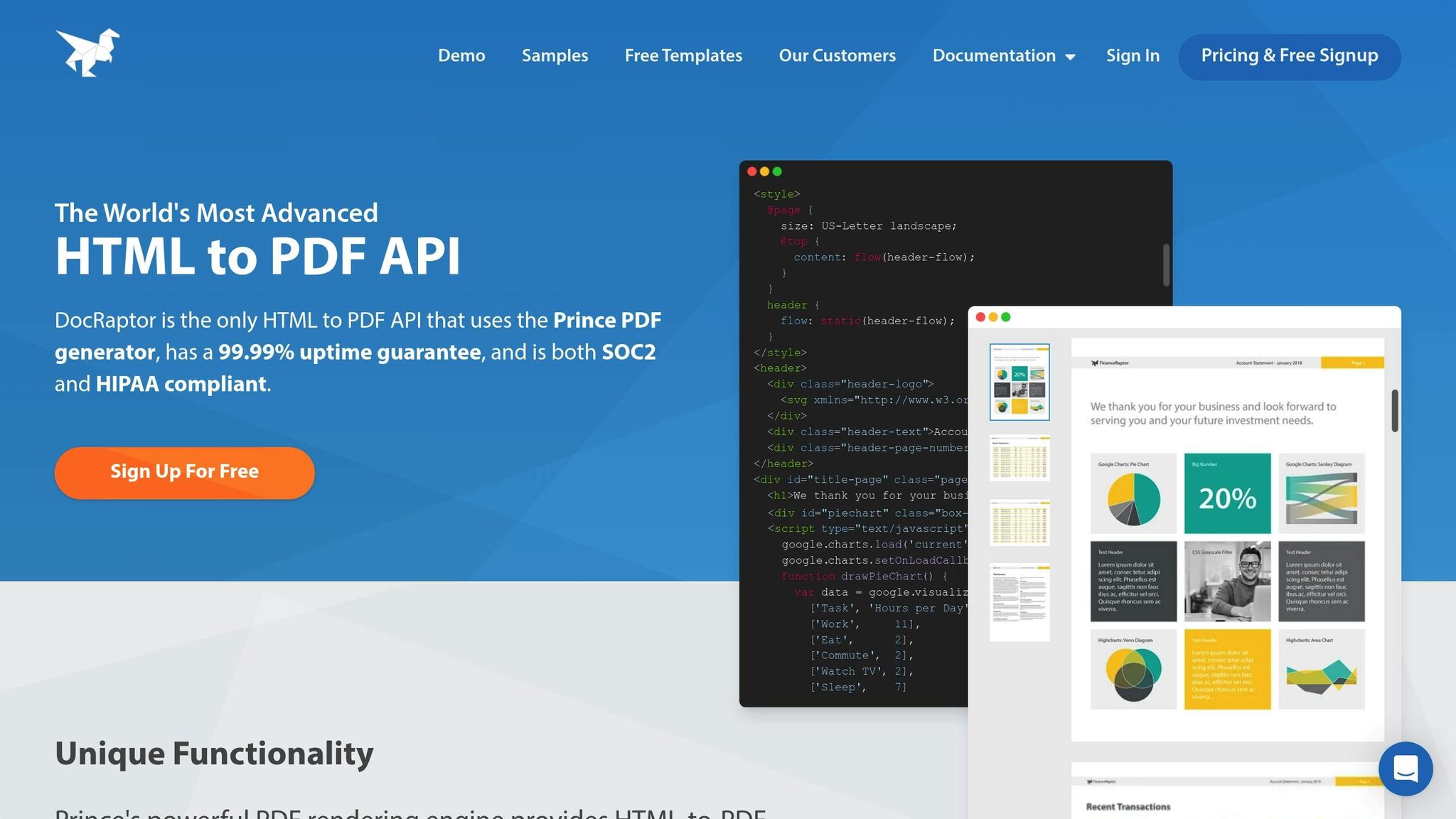
DocRaptor is an HTML to PDF conversion service designed with precision rendering and advanced CSS support in mind. Its ability to handle intricate web layouts and ensure pixel-perfect output makes it a strong contender among document generation tools. If your project demands accurate reproduction of complex designs, DocRaptor is worth considering.
Conversion Accuracy
DocRaptor supports a wide range of CSS features, including flexbox, grid layouts, custom fonts, and responsive print rules. This ensures that even the most elaborate designs are accurately converted into PDFs. It’s particularly effective for projects like marketing materials, detailed reports, or web pages with advanced styling.
The platform also lets you define separate CSS rules for print media, enabling the creation of professional-looking PDFs while preserving the original design's integrity. Additionally, its JavaScript rendering capabilities ensure that dynamic, interactive web content translates seamlessly into static PDF documents.
Performance
For quick results, DocRaptor uses synchronous processing to handle standard documents efficiently. If you're dealing with larger files or batch jobs, asynchronous processing is available and can manage documents up to 200 pages without a hitch.
Response times typically range from 2 to 10 seconds, depending on document complexity. The platform is built to handle multiple concurrent requests, making it a reliable choice for applications that require frequent or high-volume document generation.
Security
DocRaptor prioritizes data security by using HTTPS encryption for all API communications. To safeguard sensitive information, it automatically deletes generated files after a set retention period.
For asynchronous tasks, the platform provides webhook notifications, so you can monitor document processing without constant server polling. Enterprise users benefit from dedicated processing environments, which offer enhanced isolation and additional security measures.
Pricing
DocRaptor uses a credit-based pricing model, where one credit equals approximately one page of output. The starter plan begins at $19 per month, offering 1,000 credits.
As you move to higher-tier plans, you’ll find volume discounts and perks like faster processing and longer document retention. For businesses with unique needs, enterprise plans include custom pricing and specialized features like dedicated resources and compliance options. A free trial is also available, allowing you to test the service with 5 documents before committing to a paid plan.
sbb-itb-bf53d11
4. PDF.co
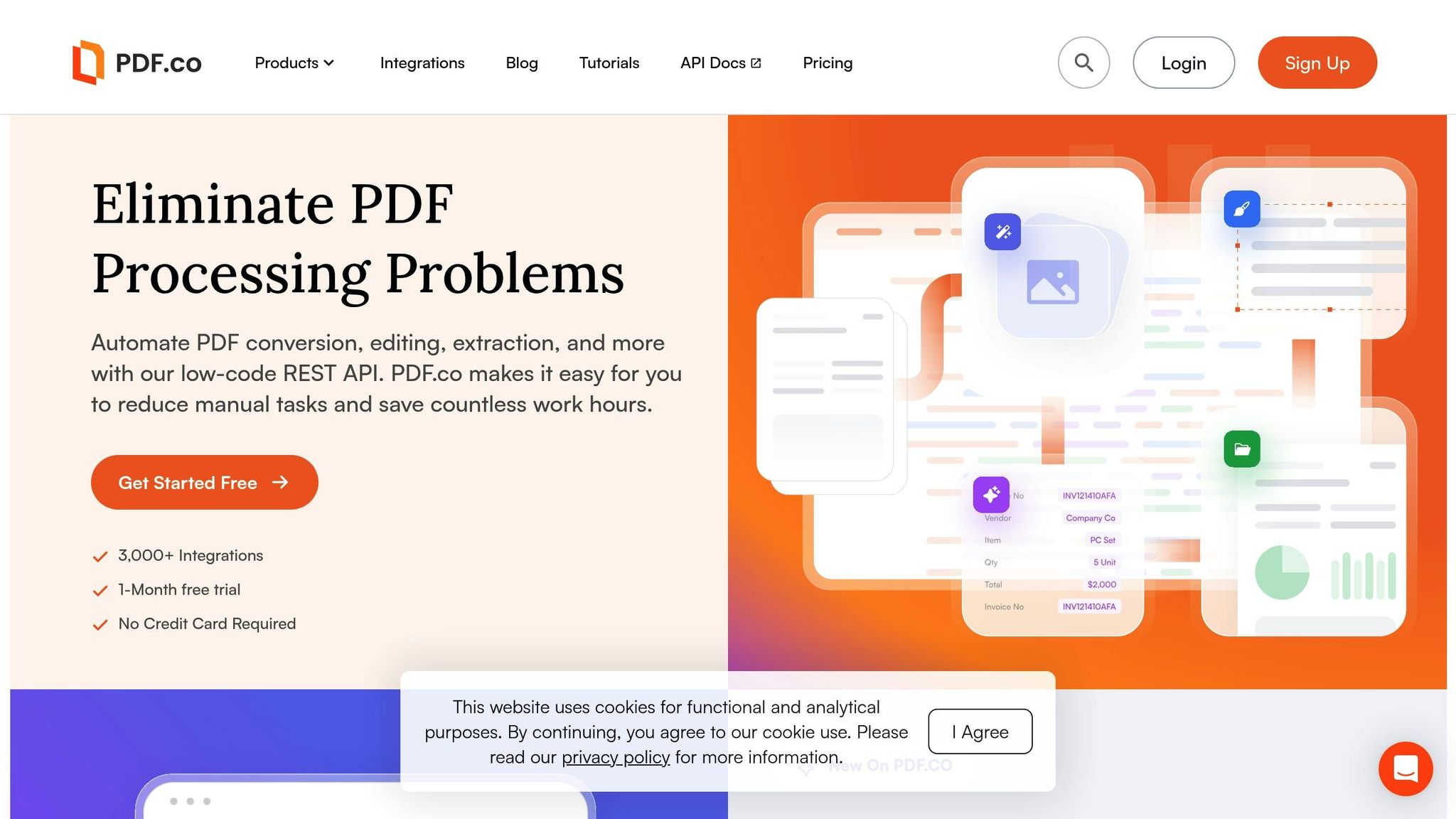
PDF.co is built with enterprise-grade security and flexible pricing to handle the demands of modern document workflows. Running on Amazon AWS infrastructure, it combines efficient document processing with strong data protection and compliance measures. Its credit-based system makes it accessible for projects of any size, from small-scale tasks to large enterprise operations. Below, we’ll dive into its accuracy, performance, security, and pricing.
Conversion Accuracy
PDF.co is known for its reliable HTML-to-PDF conversions, handling complex layouts and styling with ease. The platform consistently produces accurate results across a variety of document formats. Beyond basic PDF conversion, its API can handle tasks like merging, splitting, and transforming documents into different formats. To ensure precision, documents are processed primarily in-memory, minimizing the risk of data corruption. Additionally, it supports password-protected files, allowing users to input passwords for secure document handling.
Performance
Thanks to Amazon AWS's high-availability infrastructure, PDF.co delivers fast and efficient processing. Features like automatic server rotation and configurable file retention enhance its performance. Files are stored using randomized names for added security, and users can set custom retention periods. By default, output links expire after 1 hour, but this can be adjusted from as little as 1 minute to as long as 24 days, depending on user needs.
Security
Security is a priority for PDF.co. Files are encrypted at rest using AES 256-bit encryption, while data transmissions are secured with TLS/SSL protocols. For users needing extra control, the platform offers user-defined encryption options, supporting AES 128-bit, 192-bit, or 256-bit encryption for both input and output files. Additional security features include IP address allowlists and Single Sign-On (SSO) for access control. For sensitive operations, the Strict API logging mode ensures that all request and response data are fully redacted from logs. Operating on AWS data centers, PDF.co complies with industry-leading standards such as ISO 27001, SOC 1 Type II, SOC 2 Type I, and PCI Level 1 certifications. It is also SOC 2 (Type 2) compliant.
"Security is important to us. We use SSL and TLS security and file encryption at rest to protect your data. You can also add user-controlled AES encryption and decryption for your data. Our servers are hosted on the world-class infrastructure at Amazon AWS to keep your data safe and secure."
Pricing
PDF.co uses a credit-based pricing model, where credits determine the number of pages you can process. It offers a variety of plans to meet different needs. The Pay As You Go (free) plan provides basic access to all API endpoints with encrypted data transfer. Paid plans start with the Basic plan at $9.99 per month, which includes 16,500 credits (enough for up to 8,250 pages). The Personal plan, priced at $24.99 per month, offers 37,000 credits for up to 18,500 pages. For businesses, plans range from $49.99 to $299.99 per month. The highest-tier plan includes 483,000 credits, allowing for up to 241,500 pages. Business plans also come with advanced features like extended output link expiration (up to 1,440 minutes), private technical support, IP allowlists, and SSO integration. This flexible pricing structure accommodates both individual developers and large enterprises, offering unlimited output files and extensive integrations.
Advantages and Disadvantages
Breaking down the pros and cons of the HTML2PDF API helps paint a clear picture of what it brings to the table and where it might present challenges.
Advantages
- Simple pricing options: The API offers a free tier that includes 50 conversions, making it perfect for testing or small-scale projects. For more extensive needs, the Pro plan costs $17 per month and allows up to 5,000 conversions and 100 API requests per minute.
- Versatile output formats: It doesn't just stop at PDFs. You can also generate images, videos, and HTML files. Plus, it integrates with Amazon S3 for secure storage.
Considerations
- Rate limits: For high-volume applications, the API's rate limits might require careful planning to avoid disruptions.
Overall, HTML2PDF API balances affordability and functionality, making it a flexible choice for various document generation tasks.
Conclusion
Choosing the right document generation API boils down to three main considerations: scalability, integration capabilities, and budget alignment. Ultimately, the best choice depends on your unique requirements.
For businesses handling high volumes of document generation, it’s crucial to select an API with flexible pricing and reliable performance. APIs with tiered pricing structures are ideal for scaling, though costs can increase with more complex documents. For example, HTML2PDF API offers a straightforward Pro plan at $17 per month for 5,000 conversions, making it a predictable option for growing businesses.
Integration flexibility is another essential factor. APIs that support RESTful endpoints, multiple programming language SDKs, and workflow automation tools can significantly simplify implementation. For instance, integration with workflow automation tools allows businesses to automate document workflows without needing custom code. This feature is especially useful for U.S. companies aiming to streamline processes while ensuring compatibility with their existing systems.
Budget planning is equally important. Some APIs charge per document, while others offer subscription-based pricing. Free tiers and trial periods are great for startups or small projects, enabling thorough testing before committing. To avoid unexpected expenses, accurately estimate your usage patterns and consider the complexity of the documents you’ll generate.
Take advantage of free trials and testing periods to evaluate how well an API handles your specific needs. Testing reveals how the API performs with your document formats, localization requirements (like U.S. currency formatting: $1,234.56), and integration scenarios. Real-world testing often uncovers differences in performance that might not be apparent from technical specs alone.
Involve both technical and business stakeholders early in the decision-making process. Developers can evaluate how easily the API integrates and meets technical requirements, while business teams can provide insights into volume needs and budget constraints. This collaborative approach ensures the API meets both operational and financial goals.
FAQs
What should I look for when selecting a document generation API for my business?
When choosing a document generation API, prioritize scalability, security, and integration simplicity. These factors ensure the API can expand alongside your business, safeguard sensitive information, and integrate smoothly with your current systems.
It's also important to consider customization features and the level of vendor support available. These aspects allow you to adapt the API to your unique requirements and quickly resolve any technical issues that may arise.
You should also assess the API's capacity to manage complex workflows and its compatibility with your existing technical environment. A dependable and stable API guarantees consistent performance, while features like dynamic content rendering and automated document creation can simplify common challenges in web development and system integration.
How can I make sure the document generation API I choose complies with U.S. security and regulatory standards?
To ensure the document generation API you choose meets U.S. security and regulatory standards, focus on features like strong encryption protocols (such as TLS 1.3) and regular security audits. If the API handles sensitive payment information, it should comply with PCI DSS, while healthcare-related documents require adherence to HIPAA regulations.
You might also consider frameworks like NIST SP 800-53, which outline best practices for securing APIs and protecting sensitive data. Opt for APIs that integrate security into their core design and provide thorough documentation on compliance measures. This approach helps reduce risks and ensures your data remains protected.
What are the advantages of a credit-based pricing model compared to a subscription plan for document generation APIs?
A credit-based pricing model offers a flexible way to manage costs by letting you buy credits in advance and use them whenever you need. This approach is especially helpful if your usage tends to fluctuate. During slower periods, you can avoid paying for unused capacity, while still having the resources ready for busier times.
Another advantage is the simplicity it brings to budgeting. With this model, you get predictable spending without locking yourself into a fixed monthly or yearly subscription. For businesses with varying workloads, it’s a practical option - you only pay for what you actually use, making it an efficient choice for handling diverse document generation demands.
